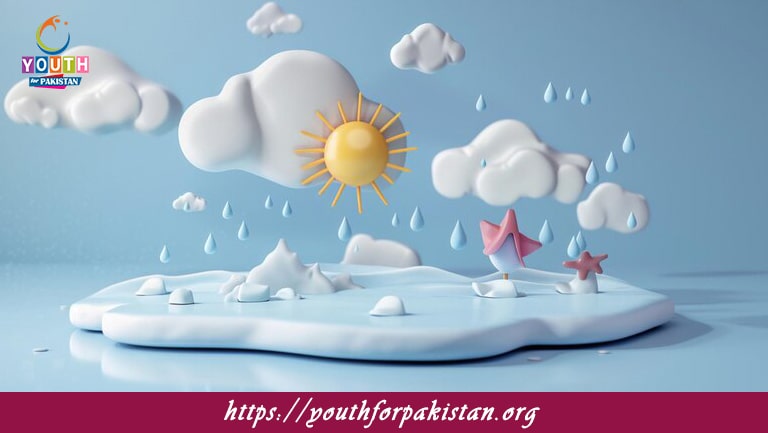Welcome to the Weather and Climate MCQs with Answers. In this post, we are sharing Weather and Climate Multiple Choice Questions and Answers in Everyday Science section for various competitive exams in Pakistan. Each question offers a chance to enhance your knowledge regarding Weather and Climate online MCQs Test.
Which layer of the atmosphere contains most of the Earth’s weather phenomena?
A) Troposphere
B) Stratosphere
C) Mesosphere
D) Thermosphere
What is the instrument used to measure atmospheric pressure?
A) Barometer
B) Thermometer
C) Hygrometer
D) Anemometer
Which term describes the long-term average of weather patterns in a region?
A) Climate
B) Weather
C) Precipitation
D) Humidity
What is the main cause of wind?
A) Differences in air pressure
B) Earth’s rotation
C) The moon’s gravitational pull
D) Solar radiation
What type of cloud is typically associated with thunderstorms?
A) Cumulonimbus
B) Cirrus
C) Stratus
D) Cumulus
Which of the following is a major greenhouse gas contributing to global warming?
A) Carbon dioxide
B) Oxygen
C) Nitrogen
D) Helium
What is the term for the boundary between two different air masses?
A) Front
B) Isobar
C) Jet stream
D) Trade wind
Which phenomenon is caused by the Earth’s rotation and affects wind patterns?
A) Coriolis effect
B) Greenhouse effect
C) Albedo effect
D) Ozone depletion
Which scale is used to measure the intensity of hurricanes?
A) Saffir-Simpson scale
B) Richter scale
C) Fujita scale
D) Beaufort scale
What is the primary cause of sea breezes?
A) Differences in temperature between land and water
B) Earth’s tilt
C) The Coriolis effect
D) Solar flares
What is the term for the average weather conditions over a 30-year period?
A) Climate
B) Forecast
C) Weather
D) Precipitation
Which of the following best describes a monsoon?
A) Seasonal wind pattern that brings heavy rain
B) Localized thunderstorm
C) Cyclone formed over warm water
D) Persistent drought
Which instrument measures the amount of rainfall?
A) Rain gauge
B) Barometer
C) Hygrometer
D) Thermometer
Which of the following is a natural cause of climate change?
A) Volcanic eruptions
B) Fossil fuel combustion
C) Deforestation
D) Industrial emissions
What term refers to the amount of water vapor in the air?
A) Humidity
B) Pressure
C) Precipitation
D) Condensation
Which phenomenon causes warming of the Pacific Ocean and influences global weather patterns?
A) El Niño
B) La Niña
C) Jet stream
D) Trade winds
What type of climate is typically found near the equator?
A) Tropical
B) Temperate
C) Polar
D) Desert
What is the primary factor that determines a region’s climate?
A) Latitude
B) Altitude
C) Proximity to water
D) Wind speed
Which of the following weather phenomena is characterized by rapidly rotating columns of air?
A) Tornado
B) Blizzard
C) Monsoon
D) Drought
Which term refers to the effect of Earth’s atmosphere trapping heat?
A) Greenhouse effect
B) Albedo effect
C) Coriolis effect
D) Tidal effect
What type of cloud often signals fair weather?
A) Cumulus
B) Cirrus
C) Nimbus
D) Stratus
Which layer of the atmosphere contains the ozone layer?
A) Stratosphere
B) Troposphere
C) Mesosphere
D) Thermosphere
What is the main driver of ocean currents?
A) Wind
B) Earth’s rotation
C) Tides
D) Volcanic activity
Which of the following best describes a cold front?
A) Cold air moving under warm air
B) Warm air moving under cold air
C) Air masses of equal temperature
D) Cold air rotating around warm air
Which of the following is an example of a renewable energy source that helps mitigate climate change?
A) Solar energy
B) Coal
C) Oil
D) Natural gas
Which scale is used to classify tornadoes?
A) Fujita scale
B) Saffir-Simpson scale
C) Beaufort scale
D) Richter scale
What is the term for the process by which plants release water vapor into the atmosphere?
A) Transpiration
B) Evaporation
C) Condensation
D) Precipitation
Which of the following describes a high-pressure system?
A) Clear skies and fair weather
B) Cloudy and rainy conditions
C) High winds and storms
D) Cold and snowy conditions
What type of climate is characterized by hot summers and cold winters?
A) Continental
B) Tropical
C) Polar
D) Desert
What causes the changing of the seasons on Earth?
A) Earth’s axial tilt
B) The moon’s orbit
C) Earth’s distance from the sun
D) Ocean currents
Which weather phenomenon results in heavy snowfall and strong winds?
A) Blizzard
B) Tornado
C) Hurricane
D) Drought
What is the term for the wind patterns that circle the Earth near the poles?
A) Polar easterlies
B) Trade winds
C) Westerlies
D) Jet streams
What is the process by which water vapor cools and turns into liquid droplets in the atmosphere?
A) Condensation
B) Precipitation
C) Evaporation
D) Transpiration
What is the name given to the line that separates areas of high and low pressure on a weather map?
A) Isobar
B) Isotherm
C) Front
D) Jet stream
Which of the following is responsible for the formation of hurricanes?
A) Warm ocean water
B) Cold ocean water
C) Mountain ranges
D) Solar radiation
Which of the following is an indicator of climate change?
A) Rising global temperatures
B) Decreasing levels of solar radiation
C) Shorter days
D) More oxygen in the atmosphere
What is the main characteristic of the polar climate zone?
A) Extremely cold temperatures
B) High rainfall
C) Mild winters and hot summers
D) Dry, desert conditions
Which of the following describes a tropical cyclone?
A) A storm system that forms over warm ocean water
B) A tornado formed over land
C) A type of cloud formation
D) A front that brings cold air
If you are interested to enhance your knowledge regarding Physics, Chemistry, Computer, and Biology please click on the link of each category, you will be redirected to dedicated website for each category.








